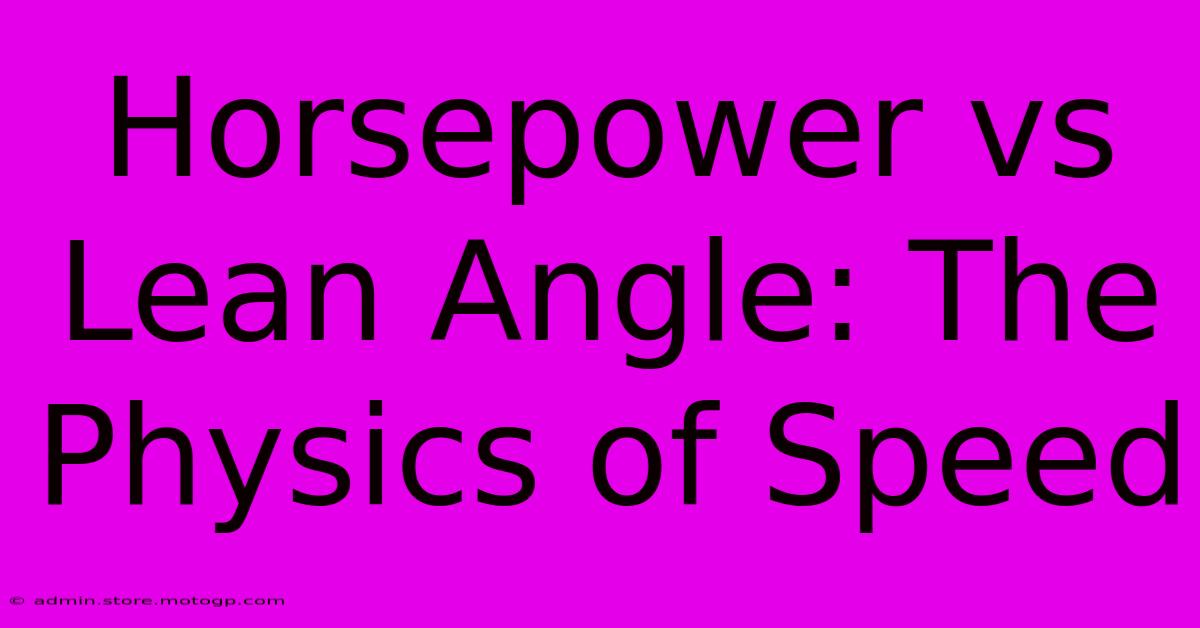Horsepower Vs Lean Angle: The Physics Of Speed

Table of Contents
Horsepower vs. Lean Angle: The Physics of Speed
For motorcycle enthusiasts, the pursuit of speed is a constant fascination. But speed isn't solely determined by raw horsepower; it's a complex interplay of power, physics, and rider skill. Understanding the relationship between horsepower and lean angle is crucial for maximizing performance and safety on two wheels. This article delves into the physics behind speed, exploring how these two key elements combine to propel a motorcycle forward.
The Role of Horsepower
Horsepower, a measure of an engine's power output, directly impacts acceleration. More horsepower generally equates to faster acceleration. A higher horsepower engine can overcome inertia more quickly, resulting in a quicker launch and higher top speed. However, horsepower isn't the only factor. The engine's torque curve – how the power is delivered across the RPM range – also significantly influences acceleration and overall performance. A broad, flat torque curve provides strong pulling power across a wider range of speeds, making it easier to maintain momentum.
Factors Affecting Horsepower's Impact:
- Gear Ratios: The transmission's gear ratios dictate how engine power is translated into wheel speed. Well-chosen gearing can maximize acceleration in different speed ranges.
- Weight: A heavier motorcycle requires more power to accelerate at the same rate as a lighter one. Reducing weight can dramatically improve acceleration and handling.
- Aerodynamics: At higher speeds, aerodynamic drag becomes a significant force opposing motion. A streamlined motorcycle design minimizes drag, allowing the engine's horsepower to be more effectively used for speed.
- Tire Grip: Even with ample horsepower, the motorcycle won't accelerate if the tires lack grip. Tire condition, type, and pressure all influence traction.
The Importance of Lean Angle
Lean angle, the degree to which a motorcycle is tilted into a turn, is essential for navigating corners at speed. It's not directly about increasing straight-line speed, but it's critical for maintaining speed through curves. Leaning allows the motorcycle to generate centripetal force, the force that keeps the bike moving in a circular path. This force is crucial for cornering at speed without losing control.
Physics of Lean:
- Centripetal Force: This force is generated by the friction between the tires and the road surface. The lean angle increases the contact patch's effective leverage, enabling the tires to generate the necessary centripetal force.
- Friction Limit: There's a limit to the friction available between the tires and the road. Exceeding this limit, either by leaning too much or accelerating too hard while leaned over, results in a loss of traction and potentially a crash.
- Rider Skill: The ability to smoothly control lean angle is a crucial skill for safe and fast cornering. Experienced riders can maintain optimal lean angles while smoothly accelerating or braking through turns.
The Interplay of Horsepower and Lean Angle
The relationship between horsepower and lean angle isn't simply additive. They interact in complex ways:
- High Horsepower, Controlled Lean: A powerful motorcycle requires precise control of lean angle. The increased acceleration capabilities necessitate careful management of traction to avoid exceeding the friction limit in corners.
- Optimal Lean for Maximum Speed: Finding the optimal lean angle for a given corner is vital for maintaining speed. Too little lean results in a wider turning radius and slower cornering speed, while too much lean risks losing traction.
- Rider Feedback and Adjustment: Experienced riders constantly adjust their lean angle and throttle input based on road conditions, tire grip, and the motorcycle's dynamics. This dynamic feedback loop is essential for maximizing speed and safety.
Conclusion: Mastering the Balance
Speed on a motorcycle is not just about horsepower; it's about skillfully harnessing the interplay between power and physics. Understanding the role of lean angle, coupled with a deep understanding of your motorcycle's capabilities and limitations, allows for a more enjoyable and safer ride. Mastering this balance is the key to unlocking true speed and performance. Always prioritize safe riding practices and never exceed your skill level.

Thank you for visiting our website wich cover about Horsepower Vs Lean Angle: The Physics Of Speed. We hope the information provided has been useful to you. Feel free to contact us if you have any questions or need further assistance. See you next time and dont miss to bookmark.
Featured Posts
-
The Science Behind Speed Analyzing Moto Gp Performance
Feb 20, 2025
-
Moto Gp Sprint Race Get Your Results Here
Feb 20, 2025
-
Speed Moto Gp The Feeling Of Freedom
Feb 20, 2025
-
F1 Ratings Understanding Driver Consistency
Feb 20, 2025
-
Yamaha V4 Moto Gp The Champions Choice
Feb 20, 2025
